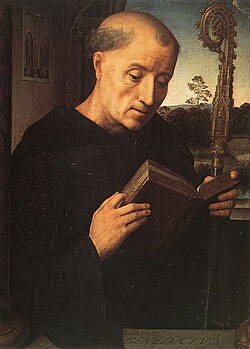
Back Benediktus van Nursia Afrikaans Benedikt von Nursia ALS بندكت النيرسي Arabic بندكت النيرسى ARZ Benitu de Nursia AST Benedikt vo Nursia BAR Бенедыкт Нурсійскі Byelorussian Бэнэдыкт Нурсійскі BE-X-OLD Бенедикт Нурсийски Bulgarian Benead Norcia Breton
This article needs additional citations for verification. (August 2023) |
Benedict of Nursia | |
|---|---|
 A portrait of Saint Benedict as depicted in the Benedetto Portinari Triptych, by Hans Memling | |
| Founder of the Benedictine Order, Exorcist, Mystic, Abbot of Monte Cassino, and Father of Western Monasticism | |
| Born | 2 March 480 Nursia, Kingdom of Italy |
| Died | 21 March 547 (aged 67) Mons Casinus, Eastern Roman Empire |
| Venerated in | All Christian denominations which venerate saints |
| Canonized | 1220, Rome, Papal States by Pope Honorius III |
| Major shrine | Monte Cassino Abbey, with his burial Saint-Benoît-sur-Loire, near Orléans, France |
| Feast | 11 July (General Roman Calendar, Lutheran Churches, Anglican Communion) 14 March (Eastern Orthodox Church) 21 March (pre-1970 General Roman Calendar) |
| Attributes |
|
| Patronage |
|
Benedict of Nursia OSB (Latin: Benedictus Nursiae; Italian: Benedetto da Norcia; 2 March AD 480 – 21 March AD 547), often known as Saint Benedict, was an Italian Christian monk, writer, and theologian. He is venerated in the Catholic Church, the Eastern Orthodox Church, the Oriental Orthodox Churches, the Lutheran Churches, the Anglican Communion, and Old Catholic Churches.[3][4] In 1964 Pope Paul VI declared Benedict a patron saint of Europe.[5]
Benedict founded twelve communities for monks at Subiaco in present-day Lazio, Italy (about 65 kilometres (40 mi) to the east of Rome), before moving further south-east to Monte Cassino in the mountains of central Italy. The present-day Order of Saint Benedict emerged later and, moreover, is not an "order" as the term is commonly understood, but a confederation of autonomous congregations.[6]
Benedict's main achievement, his Rule of Saint Benedict, contains a set of rules for his monks to follow. Heavily influenced by the writings of John Cassian (c. 360 – c. 435), it shows strong affinity with the earlier Rule of the Master, but it also has a unique spirit of balance, moderation and reasonableness (ἐπιείκεια, epieíkeia), which persuaded most Christian religious communities founded throughout the Middle Ages to adopt it. As a result, Benedict's Rule became one of the most influential religious rules in Western Christendom. For this reason, Giuseppe Carletti regarded Benedict as the founder of Western Christian monasticism.[7]
- ^
Lanzi, Fernando; Lanzi, Gioia (2004) [2003]. Saints and Their Symbols: Recog [Come riconoscere i santi]. Translated by O'Connell, Matthew J. Collegeville, Minnesota: Liturgical Press. p. 218. ISBN 9780814629703. Retrieved 26 October 2023.
Benedict of Nursia [...] Principal attributes: black monastic garb, staff, book with inscription: "Pray and Work."
- ^ "Saint Benedict of Nursia: The Iconography". Archived from the original on 27 November 2022. Retrieved 27 November 2022.
- ^ Barry, Patrick (1995). St. Benedict and Christianity in England. Gracewing Publishing. p. 32. ISBN 9780852443385.
- ^ Ramshaw, Gail (1983). Festivals and Commemorations in Evangelical Lutheran Worship (PDF). Augsburg Fortress. p. 299.
- ^
Barrely, Christine; Leblon, Saskia; Péraudin, Laure; Trieulet, Stéphane (23 March 2011) [2009]. "Benedict". The Little Book of Saints [Petit livre des saints]. Translated by Bell, Elizabeth. San Francisco: Chronicle Book. p. 34. ISBN 9780811877473. Retrieved 26 October 2023.
Declared the patron saint of Europe in 1964 by Pope Paul VI, Benedict is also the patron of farmers, peasants, and Italian architects.
- ^ Holder, Arthur G. (2009). Christian Spirituality: The Classics. Taylor & Francis. p. 70. ISBN 9780415776028. Archived from the original on 20 February 2023. Retrieved 23 March 2016.
Today, tens of thousands of men and women throughout the world profess to live their lives according to Benedict's Rule. These men and women are associated with over two thousand Roman Catholic, Anglican, and ecumenical Benedictine monasteries on six continents.
- ^ Carletti, Giuseppe, Life of St. Benedict (Freeport, NY: Books for Libraries Press, 1971).
© MMXXIII Rich X Search. We shall prevail. All rights reserved. Rich X Search